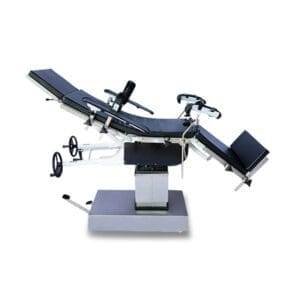عنوان
304 شارع الكاردينال الشمالي
مركز دورتشستر ، ماساتشوستس 02124
ساعات العمل
من الاثنين إلى الجمعة: 7 صباحًا - 7 مساءً
عطلة نهاية الأسبوع: 10 صباحًا - 5 مساءً
تُمثل العمليات الجراحية جانبًا بالغ الأهمية في الرعاية الصحية الحديثة، ويعتمد نجاحها على مزيج من المهارة والدقة والمعدات المناسبة. ومن بين الأدوات الأساسية في غرفة العمليات، تُعدّ طاولة العمليات اليدوية (OT Table) قطعةً أساسيةً من المعدات التي تلعب دورًا محوريًا في ضمان سلامة المرضى وفعالية العمليات الجراحية. في هذا الاستكشاف الشامل، سنتعمق في الدور متعدد الجوانب لطاولات العمليات اليدوية في العمليات الجراحية، مُسلّطين الضوء على أهميتها وتعدد استخداماتها وتأثيرها على نتائج المرضى.
تُعدّ طاولات العمليات الجراحية اليدوية أساسيةً في ممارسة الجراحة. فهي تُوفّر منصةً ثابتةً للمرضى خلال مختلف الإجراءات الطبية، مُتيحةً مجموعةً واسعةً من التعديلات والوظائف لتلبية الاحتياجات المُحدّدة لكلّ حالة جراحية. في حين اكتسبت طاولات العمليات الجراحية الآلية رواجًا كبيرًا في السنوات الأخيرة، لا تزال طاولات العمليات الجراحية اليدوية تتبوأ مكانةً بارزةً في المشهد الجراحي بفضل موثوقيتها وفعاليتها من حيث التكلفة.
 تعديل الارتفاع
تعديل الارتفاعمن الوظائف الأساسية لطاولات العمليات اليدوية تحديد وضعية المريض بدقة. يُعدّ تعديل الارتفاع أمرًا بالغ الأهمية لاستيعاب الجراحين من مختلف القامات، وتحسين مجال رؤية الجراح وبيئة عمله أثناء العملية.
عادةً ما توفر طاولات العلاج المهني اليدوية مجموعة متنوعة من خيارات الإمالة، بما في ذلك وضعيات ترندلنبورغ وترندلنبورغ العكسية. تُعد هذه التعديلات أساسية في إدارة اتجاه المريض وضمان الوصول إلى موضع الجراحة بمساعدة الجاذبية.
تُعد إمكانية الإمالة الجانبية في طاولات العلاج الوظيفي اليدوية أمرًا بالغ الأهمية في الإجراءات التي تتطلب وصولًا جانبيًا للمريض، مثل جراحات العظام والعمود الفقري. فهي تُمكّن الجراحين من تحقيق الزوايا المطلوبة لتحقيق رؤية ووصول مثاليين.
طاولات الجراحة اليدوية متعددة الاستخدامات ومناسبة تمامًا لإجراءات الجراحة العامة. فهي تستوعب مجموعة واسعة من التخصصات الجراحية، بما في ذلك جراحات البطن، واستئصال الزائدة الدودية، وإصلاح الفتق.
غالبًا ما تتطلب إجراءات تقويم العظام دقةً في الوضع والثبات. توفر طاولات العلاج الطبيعي اليدوية التعديلات اللازمة لاستبدال المفاصل، وإصلاح الكسور، وجراحات العمود الفقري.
في جراحة القلب والصدر، يُعدّ وضع المريض أمرًا بالغ الأهمية. يمكن تهيئة طاولات العلاج الوظيفي اليدوية لدعم جراحات مثل مجازة الشريان التاجي (CABG) وعمليات القلب المفتوح.
تتطلب إجراءات جراحة الأعصاب دقةً فائقة. وتُعدّ طاولات العلاج الوظيفي اليدوية أساسيةً في تحديد الوضع الدقيق للرأس والجسم اللازم لعمليات فتح الجمجمة وجراحات العمود الفقري.
غالبًا ما تُصنع طاولات العمليات الجراحية اليدوية من مواد عالية الجودة، مثل الفولاذ المقاوم للصدأ أو الألومنيوم المتين. يضمن هذا البناء المتين قدرة الطاولات على تحمل ظروف غرفة العمليات القاسية وتوفير سنوات من الخدمة الموثوقة.
صيانة طاولات العمليات اليدوية سهلة نسبيًا، إذ تتطلب صيانة أقل تعقيدًا مقارنةً بنظيراتها الآلية. هذا البساطة تُترجم إلى تقليل وقت التوقف عن العمل وتوفير التكاليف لمرافق الرعاية الصحية.
-300x300.jpg) مكافحة العدوى
مكافحة العدوىتُعدّ مكافحة العدوى أمرًا بالغ الأهمية في البيئات الجراحية. صُممت طاولات غرف العمليات اليدوية بأسطح ناعمة وسهلة التنظيف والتطهير، مما يقلل من خطر العدوى المرتبطة بالرعاية الصحية.
سلامة المرضى أولوية قصوى أثناء العمليات الجراحية. يساهم ثبات طاولات العمليات اليدوية وقابليتها للتعديل في تعزيز سلامة المرضى من خلال ضمان بقائهم آمنين ومريحين طوال العملية.
تتميز طاولات العمليات اليدوية بسهولة استخدامها وفعالية إعدادها. هذه البساطة تُوفر وقتًا ثمينًا في غرفة العمليات، مما يُسهم في تحسين سير العمل الجراحي وكفاءته.
غالبًا ما تكون طاولات العمليات الجراحية اليدوية متوافقة مع مختلف أجهزة التصوير، مثل أجهزة الأشعة السينية وأجهزة التنظير الفلوري. يُعد هذا التوافق بالغ الأهمية للجراحات الموجهة بالصور والتصوير الفوري.
ج١: لا، لا تزال طاولات العمليات الجراحية اليدوية تلعب دورًا هامًا في العمليات الجراحية. فبينما توفر الطاولات الآلية ميزات متقدمة، تظل الطاولات اليدوية ذات أهمية نظرًا لموثوقيتها وفعاليتها من حيث التكلفة وملاءمتها لمجموعة واسعة من العمليات الجراحية.
ج٢: بعض طاولات التشغيل اليدوية توفر إمكانية ترقية محدودة بإضافة ملحقات أو ملحقات. ومع ذلك، قد لا تتطابق إمكانية الترقية مع الميزات المتقدمة المتوفرة في الطاولات الآلية. ينبغي على المنشآت تقييم احتياجاتها الخاصة عند التفكير في الترقية.
ج٣: تُعزز طاولات العمليات الجراحية اليدوية سلامة المرضى من خلال توفير الثبات، والدقة في تحديد المواقع، والتوافق مع أجهزة التصوير. تضمن هذه الميزات بقاء المرضى آمنين، ومريحين، وفي الوضع الأمثل للإجراءات الجراحية، مما يُحسّن نتائجهم في نهاية المطاف.
دليل التشغيل الجداول تُعدّ طاولات العمليات الجراحية من الأدوات الأساسية في عالم العمليات الجراحية. فقدرتها على التكيف، وموثوقيتها، وقدرتها على تسهيل تحديد موضع المريض بدقة، تجعلها أداةً أساسيةً للجراحين في مختلف التخصصات. ومع استمرار تطور التكنولوجيا، يبقى دور طاولات العمليات اليدوية في ضمان سلامة المرضى ونجاح العمليات الجراحية راسخًا. وفي ظلّ التغيرات المتسارعة في قطاع الرعاية الصحية، لا تزال طاولات العمليات اليدوية تلعب دورًا حيويًا في السعي لتحقيق التميز في الرعاية الجراحية.
